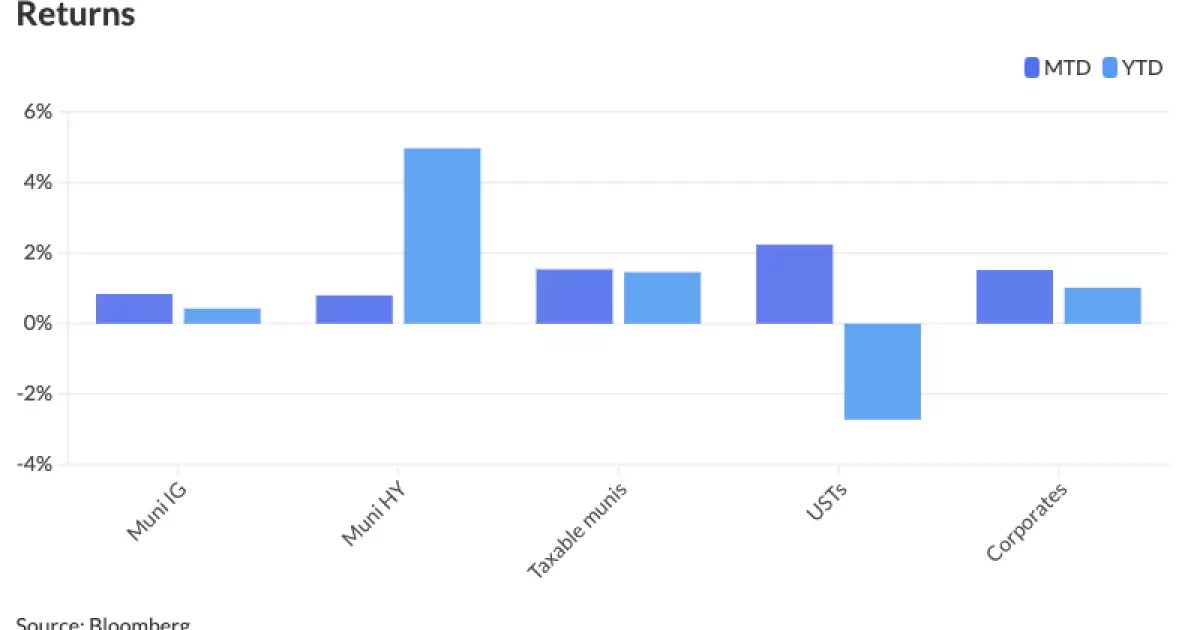The municipal bond market has displayed a relatively stable performance recently, despite fluctuations occurring in associated sectors such as U.S. Treasuries and equities. As we delve deeper into the intricacies of the market’s movements, it becomes crucial to scrutinize the current trends and their implications on investors and issuers alike.
On a significant trading day recently, municipal bonds showed minimal changes, remaining largely unchanged amid a firmer U.S. Treasury market and mixed performance in equities. Observers noted that while municipal bonds are exhibiting an overall stability, the yields on these securities have been trending downwards, averaging a reduction of 15 basis points across the curve this month alone. Jason Wong, vice president of municipals at AmeriVet Securities, highlighted this gradual decline but quickly pointed out that current yields remain elevated compared to earlier in the year. For instance, the yield on 10-year municipal bonds fell by 2.2 basis points last week, positioning at 2.78%—a stark increase of 50 basis points since the start of the year when it stood at 2.28%.
This dichotomy—the short-term decline in yields contrasted with long-term increases—poses strategic challenges for investors looking to optimize their portfolios and manage risks effectively. Wong’s commentary on the increased yields indicates ongoing pressure on the municipal bond market, emphasizing the need for potential investors to remain vigilant regarding interest rate movements and broader economic indicators.
Diving deeper into yield comparisons, it’s critical to assess how municipal bonds measure up against their Treasury counterparts. Wong noted that although municipal bonds are currently cheaper than Treasury securities, the overall market remains rich. Specifically, the 10-year ratio was documented at 58.48% at the start of the year but sits at notably lower metrics when compared against its historical average of 86.50%.
The significance of these ratios cannot be understated; these metrics guide investors in understanding price valuations within the market and adjusting their strategies accordingly. Additionally, various muni-to-Treasury ratios were reported for several maturities, indicating slightly varied comparative strength depending on the duration of investment. For example, the two-year ratio stood at 65%, whereas the longer 30-year ratio was at 83%. These figures reveal a nuanced view of demand across different maturities and highlight areas where opportunities may arise for tactical investment.
One of the pivotal events influencing the municipal bond market this week is the scheduled Federal Open Market Committee (FOMC) meeting. Expectations are that a positive outlook regarding inflation and a possible rate cut might be discussed. Such developments are essential for municipal issuers and investors alike because a rate cut could lead to a rejuvenation of market activity. Wong speculated that should the Fed proceed with a rate cut, it would likely encourage issuers to return to the markets, thereby injecting additional liquidity and potentially improving overall demand for bonds.
This speculation is bolstered by myriads of yield indicators and the current investment landscape. As investors brace for these FOMC announcements, market reactions are anticipated to sway not just yields but also overall market sentiment—a factor that can catalyze significant changes in liquidity and demand.
Issuance activity has faced some slowdown as we approach the impending FOMC meeting, with approximately $6.6 billion anticipated in municipal issuance. Despite this decrease, the market appeared well-balanced, largely attributing its stability to recent active primary market conditions. For instance, major players like Wells Fargo initiated a one-day retail period on notable general obligation bonds for New York City, showcasing continued interest among investors for large-scale projects.
A noteworthy observation in the market is the substantial cash inflows noted recently, which could indicate a strategic rotation by investors looking to capitalize on more attractive new issues. LSEG Lipper reported an inflow of $866 million last week, emphasizing strong investor appetite for long-term funds, an encouraging sign for the market’s resilience under current pressures.
The present landscape of municipal bonds is characterized by steady yields, varying ratios compared to Treasuries, and an optimistic outlook contingent upon Federal Reserve actions. As the market prepares for potential shifts post-FOMC meetings, investors would do well to adopt a proactive approach, anticipating changes in not only yield dynamics but also overall market sentiment. Indeed, as conditions evolve, continuous reevaluation will be crucial in ensuring that strategies align with both current yields and the anticipated broader economic context. With the right discernment, opportunities to optimize portfolios and mitigate risks will undoubtedly emerge in this fluid and accommodating environment.


Leave a Reply